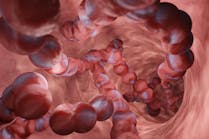[Note: Part I of hCG testing was published in MLO's February 2011 issue. See Part I.]
Serum quantitative assays: The principle of the modern laboratory hCG immunoassay is based on the sandwich technique whereby a capture antibody binds one site on hCG, immobilizing it and a signaling antibody — labeled with an enzyme (EIA) or with radioactive iodine (RIA) — binding a distant site on hCG, labeling the immobilized complex. The immobilized and labeled complex can then be quantified, with the signal being directly proportional to the amount of complex or concentration of hCG.
There are two clear categories of hCG test: 1) intact hCG tests which are designed to detect the intact dimer only; while 2) total hCG tests (most commonly used in commercial laboratories) — also known as b-hCG tests — are designed to detect the dimer, as well as the free b-subunit, and possibly nicked and other variants of hCG. Total hCG assays most commonly involve an antibody to the b-subunit folded core combined with an antibody to the b-subunit CTP natural to ensure minimal cross-reactivity with luteinizing hormone (LH), since LH does not have a 30-amino-acid CTP.7
These assays are limited by the effect of antibody epitopes on assay specificity. The use of monoclonal antibodies with known epitope specificity in hCG assays facilitates the design of these assays with respect to various forms of hCG.15 The epitopes of 28 monoclonal antibodies from various manufacturers were analyzed.16 The monoclonal antibodies can be subdivided into those recognizing bhCG only, and those recognizing both hCG and bhCG. Antibodies of the second group were either specific for hCG, bhCG, and hCGcf, or specific for hCG, bhCG, and the b-subunit CTP.16 Hence, the choice of antibodies in hCG assays determines what hCG variants are detected by various hCG assays. Wide variations in the detection of hCG structural variants was found in a study of nine assays, and was attributed to differences in assay specificity, as well as in the composition of the calibrators. In addition, the majority of tests did not detect hCG or its free b-subunit missing the C-terminal segment. Only one assay, which — using the two antibodies to the b-subunit folded core — detects all pertinent standards.17
The Food and Drug Administration (FDA) approves any test that detects regular hCG. The detection of other variants of hCG, including hyperglycosylated hCG — the principal form present in early pregnancy serum and urine — and no requirement to detect free b-subunit, the only form produced by cancers. Unfortunately, in the clinical setting, all variants of hCG are considered to be one by physicians who often order an hCG test for pregnancy, gestational-trophoblastic disease, and cancer cases, regardless of the analytical specificity of the test.
Point-of-care(POC) testing: The dual antibody-sandwich techniques are also the basis of all urine POC rapid pregnancy tests. In each test, one antibody (capture) is immobilized in a translucent line in the result window, and one antibody (signal) mixes with the serum or urine and is labeled with a blue or red dye or gold matrix dye. As the hCG-dye antibody complex reaches the results window, it becomes immobilized by the action of the capture antibody, and a positive result is indicated by a line formed at this point by the immobilized antibody-hCG-dye antibody complex.7
The most common type of POC device is made of nitrocellulose and plastic. Urine is dropped with a pipette into one window, and a positive result is shown by a line or a cross in a separate window in the plastic. The sensitivity and specificity of six POC devices were evaluated.7 The sensitivity of POC devices varied from 12 IU/L to 50 IU/L. It was reported that the Quidel QuickVue and the Beckman Coulter Icon 25 tests equally detected regular and hyperglycosylated hCG, and that the Siemens Clinitest, Inverness Accreava hCG Basic II and Mainline Maxie and Confrm hCG tests poorly detected hyperglycosylated hCG relative to regular hCG. In addition, it was found that no POC tests were sensitive for detecting free b-subunit or b-core fragment, and no over-the-counter, or OTC, test detects b-core fragment.7
Standards: The third international standard (IS) (WHO code 75/537) and fourth IS (WHO code 75/589) have been widely used throughout the world for calibrating and testing all laboratory hCG tests and POC hCG assays for more than 20 years. These standards are calibrated in biological units, international units per liter — IU/L or mIU/mL. New standards have now been prepared using molar units so that measurement of hCG and degradation products is completely compatible, with efforts to purify hCG further to rid the preparation of nicked molecules and free subunits.18 The new hCG WHO standard is the first reference reagent (WHO code 99/688). WHO standards were also prepared for the separate b-subunit (WHO code 99/650), separate a-subunit (WHO code 99/720), nicked hCG (WHO code 99/642), nicked b-subunit (WHO code 99/692), and b-subunit core fragment (WHO code 99/708). All of the new standards are strictly calibrated on a molar basis. With the widespread adoption of IU/L units throughout the world, however, laboratories and manufacturers have had to refrain from adopting these new standards. Why, because they are calibrated on a molar basis?
Interferences: false-positive: In a sandwich immunoassay, a complex is formed between capture antibody and the signaling antibody. The capture and signaling antibodies can be goat, sheep, or rabbit polyclonal antibodies, or mouse, goat, or sheep monoclonal antibodies. In general, an interferent capable of bridging the capture and signaling antibodies in an immunoassay causes false-positive results. The types of interferents range from human antibodies against animals or heterophile antibodies, in addition to other conditions. Human antibodies against animal antibodies can develop in humans extensively exposed to animals or animal byproducts. In addition, humans naturally produce human anti-human immunoglobulin antibodies or heterophile antibodies that can cross-react with and bind animal antibodies. Humans with recent exposure to mononucleosis are more prone to develop antibodies against animal antibodies, and those with IgA-deficiency syndrome often have false-positive assay problems due to heterophilic antibodies.19 Human antibodies have two binding sites so that, in the case where an anti-animal antibody or heterophilic antibody is present in the serum, it can complex the capture and signaling antibodies, making a capture antibody-interfering, antibody-signaling antibody complex that causes a false-positive hCG result. False-positive hCG detection has resulted in the wrong diagnosis of gestational-trophoblastic disease, testicular cancer, and other malignancies, causing needless surgery and chemotherapy.20-22
Manufacturers have worked to avoid false-positive tests by incorporating animal serum and non-specific animal antibodies into all their test ingredients. The interference of heterophilic antibodies and human anti-animal antibodies in human-serum samples is eliminated by the presence of excess non-specific antibodies that overwhelms binding.
There are different tests that can be performed in the laboratory that identify false-positive hCG. The first is to run an hCG test in urine to show the absence of hCG. Another useful way of identifying a false-positive serum hCG result is to use a different hCG assay by a different manufacturer (if available), or to send the serum to other laboratories using different commercial assays. If the assay results vary greatly, or are negative in one or both alternative tests, then false-positive hCG can be presumed.
Interferences: false-negative: False-negative problems occur with hCG tests in cases with levels of hCG above 500,000 mIU/mL demonstrating a hook effect.9 The hook effect can cause very low hCG results or false-negative results when an extremely high hCG concentration is present due to the saturation of all antibody-binding sites on both the capture and signaling antibodies, permitting few or no complex formation. Since the FDA clears hCG tests for pregnancy use only, most hCG tests are limited in sensitivity to the pregnancy hCG range. In pregnancy, hCG rarely exceeds 200,000 mIU/mL, while hCG levels in the cases of gestational-trophoblastic disease, choricarcinoma, and other malignancies can be much higher. It is important to be wary of hook-effect problems when testing gestational-trophoblastic disease cases. hCG results can be greater than 500,000 mIU/mL, leading to this cause for false-negative tests and unduly low hCG results. Laboratories need to be informed of the need for one out of 1,000 serum dilution to avoid the hook-effect false-negative problem.
With the variation in reactivity of various assays with different hCG variants, false-negative results might arise. Extremely high concentrations of hCG variants can cause falsely decreased results in certain quantitative hCG assays. A report examining nine commercially available assays showed no false-negative results in the presence of bhCG, the variant typically associated with bhCG-producing malignancies. Two assays, however, exhibited decreased hCG results in the presence of bhCG core-fragment concentrations found during normal pregnancy.23 False-negative problems also occur with POC pregnancy tests. Increased concentrations of bhCG core fragment in urine can cause false-negative urine pregnancy tests.24 There are different tests that can be performed in the laboratory that identify false-negative hCG. The first is to run a dilution of the specimen. Diluting the original sample will dilute the amount of hCG variant that cannot be detected and, hence, free some of the saturated antibodies and give a positive result. Another useful way of identifying a false-negative hCG result is to use a different hCG assay by another manufacturer, if available, or to send the specimen to other laboratories using different commercial assays.
Charbel Abou Diwan, PhD, is a clinical chemistry post-doctoral Fellow in the Department of Pathology and Laboratory Medicine at Emory University School of Medicine in Atlanta, GA.
References
- Wide L, Gemzell CA. An immunological pregnancy test. Acta Endocrinol (Copenh) 1960;35:261-267.
- Hussa R O, Hudson EN. A two-site immunometric assay in evaluation of low levels of serum hCG. Am Clin Prod Rev. 1984; 3(12):12-17.
- Stenman UH, Alfthan H, Hotakainen K. Human chorionic gonadotropin in cancer. Clin Biochem. 2004;37(7):549-561.
-
Kovalevskaya G, Genbacev O, Fisher SJ, Caceres E, O'Connor JF. Trophoblast origin of hCG isoforms: cytotrophoblasts are the primary source of choriocarcinoma-like hCG.
Mol Cell Endocrinol. 2002;194(1-2);147-155. -
Elliott MM, Kardana A, Lustbader JW, Cole LA. Carbohydrate and peptide structure of the alpha- and beta-subunits of human chorionic gonadotropin from normal
and aberrant pregnancy and choriocarcinoma. Endocrine. 1997;7(1):15-32. -
Cole LA, Khanlian SA, Riley JM, Butler SA. Hyperglycosylated hCG in gestational implantation and in choriocarcinoma and testicular germ cell malignancy tumorigenesis.
J Reprod Med. 2006;51(11):919-929. - Cole LA. Human chorionic gonadotropin tests. Expert Rev Mol Diagn. 2009;9(7):721-747.
-
Cole LA, Khanlian SA, Sutton JM, Davies S, Stephens ND. Hyperglycosylated hCG (invasive trophoblast antigen, ITA) a key antigen for early pregnancy detection.
Clin Biochem. 2003;36(8):647-655. - Cole LA. Immunoassay of human chorionic gonadotropin, its free subunits, and metabolites. Clin Chem.1997;43(12):2233-2243.
-
Batzer FR, Schlaff S, Goldfarb AF, Corson SL. Serial beta-subunit human chorionic gonadotropin doubling time as a prognosticator of pregnancy outcome in an infertile population.
Fertil Steril. 1981;35(3):307-312. - Wald NJ, Densem JW, George L, Muttukrishna S, et al. Prenatal screening for Down's syndrome using inhibin-A as a serum marker. Prenat Diagn. 1996;16(2):143-153.
- Snyder JA, Haymond S, Parvin CA, Gronowski AM. Diagnostic considerations in the measurement of human chorionic gonadotropin in aging women. Clin Chem. 2005;51(10):1830-1805.
- Gronowski AM, Fantz CR, Parvin CA, Sokoll LJ, et al. Use of serum FSH to identify perimenopausal women with pituitary hCG. Clin Chem. 2008;54(4):652-656.
- Stenman UH, Hotakainen K, Alfthan H. Gonadotropins in doping: pharmacological basis and detection of illicit use. Br J Pharmacol. 2008;154(3):569-583.
- Stenman UH, Tiitinen A, Alfthan H,Valmu L. The classification, functions and clinical use of different isoforms of HCG. Hum Reprod Update. 2006;12(6):769-784.
-
Berger P, Sturgeon C, Bidart JM, Paus E. The ISOBM TD-7 Workshop on hCG and related molecules. Towards user-oriented standardization of pregnancy and tumor diagnosis:
assignment of epitopes to the three-dimensional structure of diagnostically and commercially relevant monoclonal antibodies directed against human chorionic gonadotropin and derivatives. Tumour Biol. 2002; 23(1):1-38. -
Cole LA, Sutton JM, Higgins TN, Cembrowski GS. Between-method variation in human chorionic gonadotropin test results.
Clin Chem. 2004;50(5):874-882. -
Birken S, Berger P, Bidart JM,Weber M. Preparation and characterization of new WHO reference reagents for human chorionic gonadotropin and metabolites.
Clin Chem. 2003;49(1):144-154. -
Knight AK, Bingemann T, Cole L, Cunningham-Rundles C. Frequent false positive beta human chorionic gonadotropin tests in immunoglobulin A deficiency.
Clin Exp Immunol. 2005;141(2):333-337. - Cole LA. Phantom hCG and phantom choriocarcinoma. Gynecol Oncol. 1998;71(2):325-329.
- Olsen TG, Hubert PR, Nycum LR. Falsely elevated human chorionic gonadotropin leading to unnecessary therapy. Obstet Gynecol. 2001;98(5 Pt 1): 843-845.
-
Rotmensch S, Cole LA. False diagnosis and needless therapy of presumed malignant disease in women with false-positive human chorionic gonadotropin concentrations.
Lancet. 2000;355(9205):712-715. -
Grenache DG, Greene DN, Dighe AS, Fantz CR. Falsely Decreased Human Chorionic Gonadotropin (hCG) Results Due to Increased Concentrations of the Free {beta} Subunit and the {beta}
Core Fragment in Quantitative hCG Assays. Clin Chem. 2010;56(12):1839-1844. -
Gronowski AM, Cervinski M, Stenman UH, Woodworth A. False-negative results in point-of-care qualitative human chorionic gonadotropin (hCG) devices due to excess hCGbeta core fragment.
Clin Chem. 2009;55(7):1389-1394.





